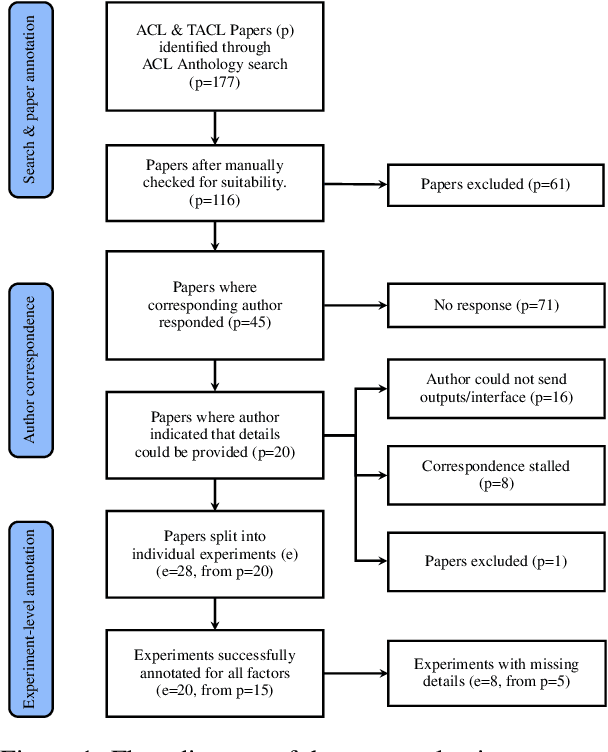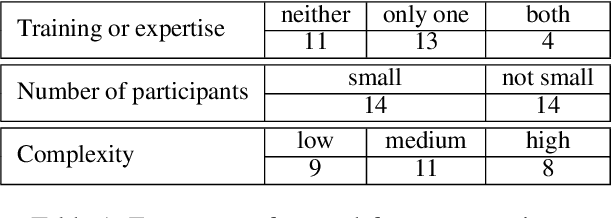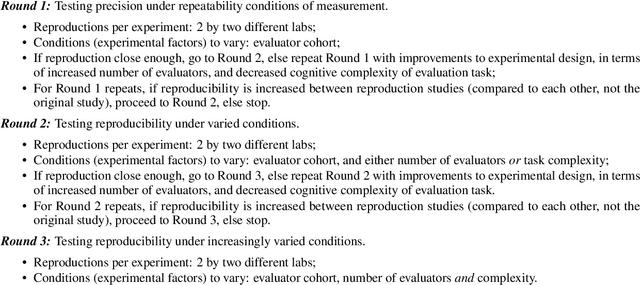Anya Belz
HEDS 3.0: The Human Evaluation Data Sheet Version 3.0
Dec 10, 2024Abstract:This paper presents version 3.0 of the Human Evaluation Datasheet (HEDS). This update is the result of our experience using HEDS in the context of numerous recent human evaluation experiments, including reproduction studies, and of feedback received. Our main overall goal was to improve clarity, and to enable users to complete the datasheet more consistently and comparably. The HEDS 3.0 package consists of the digital data sheet, documentation, and code for exporting completed data sheets as latex files, all available from the HEDS GitHub.
Reproducing the Metric-Based Evaluation of a Set of Controllable Text Generation Techniques
May 13, 2024



Abstract:Rerunning a metric-based evaluation should be more straightforward, and results should be closer, than in a human-based evaluation, especially where code and model checkpoints are made available by the original authors. As this report of our efforts to rerun a metric-based evaluation of a set of single-attribute and multiple-attribute controllable text generation (CTG) techniques shows however, such reruns of evaluations do not always produce results that are the same as the original results, and can reveal errors in the reporting of the original work.
High-quality Data-to-Text Generation for Severely Under-Resourced Languages with Out-of-the-box Large Language Models
Feb 19, 2024



Abstract:The performance of NLP methods for severely under-resourced languages cannot currently hope to match the state of the art in NLP methods for well resourced languages. We explore the extent to which pretrained large language models (LLMs) can bridge this gap, via the example of data-to-text generation for Irish, Welsh, Breton and Maltese. We test LLMs on these under-resourced languages and English, in a range of scenarios. We find that LLMs easily set the state of the art for the under-resourced languages by substantial margins, as measured by both automatic and human evaluations. For all our languages, human evaluation shows on-a-par performance with humans for our best systems, but BLEU scores collapse compared to English, casting doubt on the metric's suitability for evaluating non-task-specific systems. Overall, our results demonstrate the great potential of LLMs to bridge the performance gap for under-resourced languages.
Assessing the Portability of Parameter Matrices Trained by Parameter-Efficient Finetuning Methods
Jan 25, 2024Abstract:As the cost of training ever larger language models has grown, so has the interest in reusing previously learnt knowledge. Transfer learning methods have shown how reusing non-task-specific knowledge can help in subsequent task-specific learning. In this paper, we investigate the inverse: porting whole functional modules that encode task-specific knowledge from one model to another. We designed a study comprising 1,440 training/testing runs to test the portability of modules trained by parameter-efficient finetuning (PEFT) techniques, using sentiment analysis as an example task. We test portability in a wide range of scenarios, involving different PEFT techniques and different pretrained host models, among other dimensions. We compare the performance of ported modules with that of equivalent modules trained (i) from scratch, and (ii) from parameters sampled from the same distribution as the ported module. We find that the ported modules far outperform the two alternatives tested, but that there are interesting performance differences between the four PEFT techniques. We conclude that task-specific knowledge in the form of structurally modular sets of parameters as produced by PEFT techniques is highly portable, but that degree of success depends on type of PEFT and on differences between originating and receiving pretrained models.
Data-to-text Generation for Severely Under-Resourced Languages with GPT-3.5: A Bit of Help Needed from Google Translate
Aug 19, 2023Abstract:LLMs like GPT are great at tasks involving English which dominates in their training data. In this paper, we look at how they cope with tasks involving languages that are severely under-represented in their training data, in the context of data-to-text generation for Irish, Maltese, Welsh and Breton. During the prompt-engineering phase we tested a range of prompt types and formats on GPT-3.5 and~4 with a small sample of example input/output pairs. We then fully evaluated the two most promising prompts in two scenarios: (i) direct generation into the under-resourced language, and (ii) generation into English followed by translation into the under-resourced language. We find that few-shot prompting works better for direct generation into under-resourced languages, but that the difference disappears when pivoting via English. The few-shot + translation system variants were submitted to the WebNLG 2023 shared task where they outperformed competitor systems by substantial margins in all languages on all metrics. We conclude that good performance on under-resourced languages can be achieved out-of-the box with state-of-the-art LLMs. However, our best results (for Welsh) remain well below the lowest ranked English system at WebNLG'20.
Missing Information, Unresponsive Authors, Experimental Flaws: The Impossibility of Assessing the Reproducibility of Previous Human Evaluations in NLP
May 02, 2023



Abstract:We report our efforts in identifying a set of previous human evaluations in NLP that would be suitable for a coordinated study examining what makes human evaluations in NLP more/less reproducible. We present our results and findings, which include that just 13\% of papers had (i) sufficiently low barriers to reproduction, and (ii) enough obtainable information, to be considered for reproduction, and that all but one of the experiments we selected for reproduction was discovered to have flaws that made the meaningfulness of conducting a reproduction questionable. As a result, we had to change our coordinated study design from a reproduce approach to a standardise-then-reproduce-twice approach. Our overall (negative) finding that the great majority of human evaluations in NLP is not repeatable and/or not reproducible and/or too flawed to justify reproduction, paints a dire picture, but presents an opportunity for a rethink about how to design and report human evaluations in NLP.
PEFT-Ref: A Modular Reference Architecture and Typology for Parameter-Efficient Finetuning Techniques
Apr 24, 2023



Abstract:Recent parameter-efficient finetuning (PEFT) techniques aim to improve over the considerable cost of fully finetuning large pretrained language models (PLM). As different PEFT techniques proliferate, it is becoming difficult to compare them, in particular in terms of (i) the structure and functionality they add to the PLM, (ii) the different types and degrees of efficiency improvements achieved, (iii) performance at different downstream tasks, and (iv) how differences in structure and functionality relate to efficiency and task performance. To facilitate such comparisons, this paper presents a reference framework which standardises aspects shared by different PEFT techniques, while isolating differences to specific locations and interactions with the standard components. Through this process of standardising and isolating differences, a modular view of PEFT techniques emerges, supporting not only direct comparison of different techniques and their efficiency and task performance, but also systematic exploration of reusability and composability of the different types of finetuned modules. We demonstrate how the reference framework can be applied to understand properties and relative advantages of PEFT techniques, hence to inform selection of techniques for specific tasks, and design choices for new PEFT techniques.
Consultation Checklists: Standardising the Human Evaluation of Medical Note Generation
Nov 17, 2022



Abstract:Evaluating automatically generated text is generally hard due to the inherently subjective nature of many aspects of the output quality. This difficulty is compounded in automatic consultation note generation by differing opinions between medical experts both about which patient statements should be included in generated notes and about their respective importance in arriving at a diagnosis. Previous real-world evaluations of note-generation systems saw substantial disagreement between expert evaluators. In this paper we propose a protocol that aims to increase objectivity by grounding evaluations in Consultation Checklists, which are created in a preliminary step and then used as a common point of reference during quality assessment. We observed good levels of inter-annotator agreement in a first evaluation study using the protocol; further, using Consultation Checklists produced in the study as reference for automatic metrics such as ROUGE or BERTScore improves their correlation with human judgements compared to using the original human note.
User-Driven Research of Medical Note Generation Software
May 06, 2022



Abstract:A growing body of work uses Natural Language Processing (NLP) methods to automatically generate medical notes from audio recordings of doctor-patient consultations. However, there are very few studies on how such systems could be used in clinical practice, how clinicians would adjust to using them, or how system design should be influenced by such considerations. In this paper, we present three rounds of user studies, carried out in the context of developing a medical note generation system. We present, analyse and discuss the participating clinicians' impressions and views of how the system ought to be adapted to be of value to them. Next, we describe a three-week test run of the system in a live telehealth clinical practice. Major findings include (i) the emergence of five different note-taking behaviours; (ii) the importance of the system generating notes in real time during the consultation; and (iii) the identification of a number of clinical use cases that could prove challenging for automatic note generation systems.
Quantified Reproducibility Assessment of NLP Results
Apr 12, 2022



Abstract:This paper describes and tests a method for carrying out quantified reproducibility assessment (QRA) that is based on concepts and definitions from metrology. QRA produces a single score estimating the degree of reproducibility of a given system and evaluation measure, on the basis of the scores from, and differences between, different reproductions. We test QRA on 18 system and evaluation measure combinations (involving diverse NLP tasks and types of evaluation), for each of which we have the original results and one to seven reproduction results. The proposed QRA method produces degree-of-reproducibility scores that are comparable across multiple reproductions not only of the same, but of different original studies. We find that the proposed method facilitates insights into causes of variation between reproductions, and allows conclusions to be drawn about what changes to system and/or evaluation design might lead to improved reproducibility.
 Add to Chrome
Add to Chrome Add to Firefox
Add to Firefox Add to Edge
Add to Edge